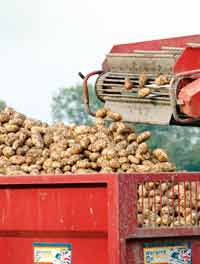Harvest woes for potato growers

A “perfect storm” of misery is hitting the potato sector as lifting slips further behind and prices fail to offset poor yields and quality and rising production costs.
Crop clearance is more than three weeks behind schedule, with just 24,000ha harvested by the end of last week, compared with more than 49,000ha by the same time last year, Potato Council data shows.
Combined with low yields, increased spraying costs and higher wastage, that has pushed average production costs over £200/t, says Potato Council chairman Allan Stevenson, who grows more than 200ha of potatoes at Luffness Mains in Scotland.
But fresh and processing potatoes are being sold at fixed prices far below that to packers and processors, who are themselves unable to fully recover their costs from retail and food service customers, says Mr Stevenson. “It is leaving a perfect storm of misery in the industry.”
“Two hundred pounds a tonne is the new £150/t,” agrees Jay Wootton of farm business consultants Andersons. His analysis shows production costs up from £140/t to £190/t. “Prices that look high at £200/t actually only offer the same margin as £150/t did when costs were just £140/t.”
Twice the number of Smith Periods during the wettest summer for 100 years has added to blight spraying costs, while delayed planting and the dullest summer since 1987 has hit yield and quality.
Greens, smalls and often severe growth cracking are widespread, typically cutting yield by 10-15%, explains David Nelson of packer Branston. Early planted crops mostly died off in August, while later plantings had too little sun.
High tuber counts mean lots of small tubers, forcing retailers to cut riddle size from 45mm to 43mm and now 40mm for specialist varieties such as Maris Piper, Desiree and King Edward. Baker size is creeping down, too, from 65mm to 60mm.
Bruising is not a big issue, but damage is, especially on dry, heavier soils. “Clods are causing splits on harvesters, with tubers too full of water if anything. I think we’re going to end up with a lot of clod in boxes,” Mr Nelson says.
With tight supplies, tubers with small defects, single growth cracks and scab flecking are all making it on to supermarket shelves. “Hopefully, the worst of the crop has been lifted, but it is still going to be challenging to get the rest out and some of it is not going to be pretty,” he adds.
GB average prices of £201/t last week may be nearly twice last year’s £109/t and a free market average of £266/t is well ahead of last year’s £95/t. But the higher unit cost of production means retailers need to raise in-store prices and pass margin back down the supply chain, says Mr Stevenson.
“There is no sense in making a terrible situation worse than it needs to be by holding down prices artificially. Almost everyone is experiencing financial pain and there is an element of internal civil war in the supply chain as there is not enough margin to cover costs and purchasers are starting to force contact terms on growers who cannot meet volume commitments given in good faith.”
It could be a watershed season, he says. Without a sustainable marketplace, many growers may decide potatoes carry too much risk compared with the relatively less demanding option of cereals.
Desiccation
Flailing and correct desiccant choice can speed last minute haulm destruction as growers seek to optimise yield and quality from late-growing crops. Applying a small amount of diquat five days before flailing reduces crop shock, advises Frontier’s Reuben Morris.
Leave about 20cm of stem and ensure all leaves are removed to aid uptake of the main diquat, spray applied at the same time. Five days later, return with Spotlight Plus (carfentrazone-ethyl) for best prevention of stem regrowth, an important factor given the high blight risk. In vigorous crops, three Reglone (diquat) sprays at seven-day intervals, with angled nozzles and 300 litres/ha of water to aid canopy penetration, then 200 litres/ha, can be as effective, says Syngenta’s Stephen Williams. Flailing in the dry should not raise blackleg risk in ware crops, says Dr Morris. Where canopies are senescing naturally and blackgrass is emerging below, Harvest (glufosinate-ammonium) is a good option, he adds.

